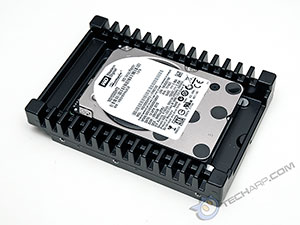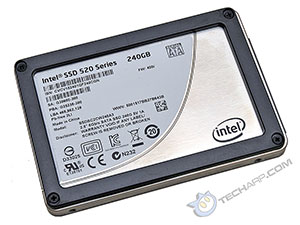Conclusion
 |
 |
The Western Digital family of VelociRaptor 10,000 RPM hard disk drives are a remarkable example of how far hard disk drives have come along. The VelociRaptor evolved from the Western Digital Raptor with just 150 GB of storage capacity in two 3.5" platters to today's Western Digital VelociRaptor with 1,000 GB of storage capacity in just three small 2.5" platters. This is almost a 7-fold increase in storage capacity and a 9-fold increase in platter areal density - all in a space of just 6 years!
As amazing as such technical developments have been, progress in SSD technology has far outpaced HDD technology. In the same space of time, SSDs have gone from slow, puny 4-8 GB drives to today's drives with storage capacities of 240 GB and even 480 GB. Their performance have also improved by leaps and bounds, as manufacturers quickly learned to deal with problems like write amplification, the slow asynchronous NAND interface and the higher latency of NAND chips. As such, it is no surprise to see the two Intel SSDs in this comparison trounce the two Western Digital VelociRaptor hard disk drives.
Technically, it is easier to ramp up the performance of solid state drives - manufacturers can easily wire multiple NAND chips to operate in parallel, rapidly increasing its throughput and masking their inherent latencies. They can also overprovision the drive, allowing for a large buffer of ready-to-write empty cells for sustained write performance. Their controllers can also employ techniques like a write accumulate buffer or on-the-fly compression to speed up writes.
Hard disk drive manufacturers, on the other hand, don't have it so easy. They have to develop new technologies to increase data density on the same sized platters they have been using for past few decades. One of these new technologies is the Advanced Format Technology, which allowed for a larger and more efficient sector size. Unfortunately, because of compatibility reasons, Western Digital had to use a 512-byte emulation mode, which greatly reduced the new VelociRaptor's random access performance - one of its key attributes, making it slower than its predecessor - the 600 GB Western Digital VelociRaptor, even as it increased its large sequential throughput.
So does this mean that the new 1 TB VelociRaptor is Western Digital's swan song for the VelociRaptor family? I think it's still too early to tell. Part of this depends on how fast Western Digital can move off the 512-byte emulation mode for Advanced Format Technology. Once they do, native AFT hard disk drives will no longer be penalized by the necessary translation to convert the 4K sector on the drive into virtual 512-byte sectors and vice versa, and should therefore perform a lot better at random accesses.
It also depends on how fast SSD manufacturers can ramp up storage capacities and bring down prices. Right now (21st August, 2012), the 1 TB VelociRaptor still commands a 4.3X price per GB advantage over the 240 GB Intel 520 Series SSD (US$ 0.25 per GB vs. US$ 1.14 per GB respectively). Unfortunately, the rapid reduction in SSD costs of yesteryears will likely slow down in the coming 2-3 years because it's getting harder to make these NAND chips smaller and cheaper.
There is also that issue of reliability - it is actually dropping for MLC NAND flash due to the finer (and less tolerant) manufacturing processes. The latest 22 nm and 34 nm Intel MLC NAND flash memory chips, for example, last just 5,000 program/erase cycles (PE cycles), even though older 50 nm Intel MLC NAND flash can last at least 10,000 PE cycles. Manufacturers will have to be more aggressive in "retiring" flash memory cells to avoid data losses; and overprovision more flash memory cells to replace them, which would further drive up costs.
At the moment though, there is no denying that solid state drives are the way to go if you are just looking for pure performance. The good ones, like the Intel 520 Series SSD, are a world ahead of the VelociRaptors. Yet, the VelociRaptors offer much larger storage capacities at a lower cost per GB, and have no limitation on how often they can be written to. So ultimately, your choice depends on which of those advantages matter more to you.
For the lowest current prices on Western Digital VelociRaptor hard disk drives, click here!
For the lowest current prices on Intel solid state drives, click here!
Support Tech ARP!
If you like our work, you can help support out work by visiting our sponsors, participate in the Tech ARP Forums, or even donate to our fund. Any help you can render is greatly appreciated!
Page |
Topic |
|
1 |
• VelociRaptors Vs. Solid State Drives |
|
2 |
• Testing The HDDs & SSDs |
|
3 |
||
4 |
||
5 |
||
6 |
||
7 |
||
8 |
||
9 |
Questions & Comments
Please feel free to post your questions or comments here!
| Date | Revision | Revision History |
06-08-2012 |
1.0 |
Initial release. |
21-08-2012 |
2.0 |
Added the Cost Per GB Analysis. |







 Add to Reddit
Add to Reddit
